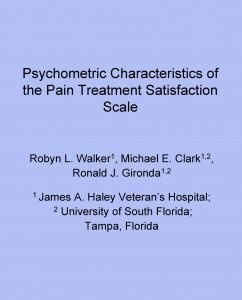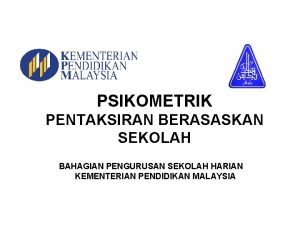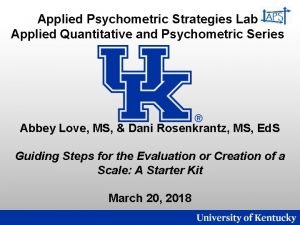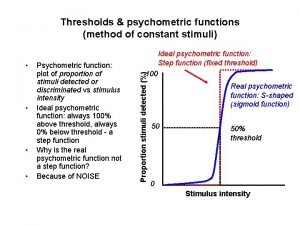Psychometric Characteristics of the Pain Treatment Satisfaction Scale
















- Slides: 16

Psychometric Characteristics of the Pain Treatment Satisfaction Scale 1 Walker , Robyn L. Michael E. 1, 2 Ronald J. Gironda 1 James 1, 2 Clark , A. Haley Veteran’s Hospital; 2 University of South Florida; Tampa, Florida

Introduction Recognition of the importance of health-related treatment outcomes in general; and pain-related outcomes in particular, has been growing. The foundation for this increased focus on pain treatment outcomes stems from the fact that effective pain assessment and treatment requires the availability of valid and reliable measures of pain-related dysfunction and treatment outcome (Clark & Gironda, 2002). There exist several reliable, valid, and comprehensive pain assessment instruments including the Multidimensional Pain Inventory (Kerns, Turk, & Rudy, 1985), and the Pain Outcomes Questionnaire (POQ) (Clark, Gironda, & Young, 2003) suitable for tracking treatment-related changes across multiple outcomes domains. One important and infrequently studied pain-related outcome is patient satisfaction with treatment services, for which there are currently no validated self-report measures. The Pain Treatment Satisfaction Scale (PTSS) was developed to fill this gap in outcomes measurement for chronic pain treatment. The PTSS consists of 5 -items from the posttreatment version of the POQ-VA. Previous research has found the PTSS to have good internal consistency and good concurrent and predictive validity (Clark, Gironda, & Young, 2003). However, further research is needed to bolster the psychometric validity and establish the construct validity of the PTSS. The purpose of the current study was to evaluate the psychometric characteristics of the PTSS, with a focus on establishing construct validity through examining concurrent outcomes variables.

Method Participants consisted of 202 individuals with chronic noncancer pain admitted between 12/02 and 12/04 to a CARF-accredited, 18 -day, inpatient interdisciplinary pain treatment program at a southeastern Veterans’ Administration Hospital. The majority of participants were military veterans, although several veteran spouses participated. Characteristics of the sample are reported in Table 1. Measures Pain Treatment Satisfaction Scale (PTSS). The PTSS consists of 5 -items from the post-treatment version of the POQ-VA. Previous research has found the PTSS to have good internal consistency and good concurrent and predictive validity (Clark, Gironda, & Young, 2003). At a 3 month follow-up appointment, patients were asked to rate their overall satisfaction with their pain treatment and whether they would recommend the program to others on a scale of 0 to 10. Pain Outcomes Questionnaire-VA Version (POQ-VA). The POQ-VA (Clark, Gironda, & Young, 2003) is a selfreport instrument that assesses pain intensity and painrelated difficulties in five outcomes domains (activities of daily living, mobility, negative affect, vitality and painrelated fear). The subscales possess excellent generalizability, acceptable test-retest reliability, good convergent and discriminant validity, and acceptable sensitivity to change. The POQ-VA was administered at program admission, discharge, and 3 month follow-up.

Method Continued Measures Continued Minnesota Multiphasic Personality Inventory – Revised (MMPI-2). The MMPI-2 (Butcher, Graham, Ben-Porath, Tellegen, Dahlstrom, & Kaemmer, 2001) is a widely accepted and empirically validated self-report inventory that assesses major patterns of personality and psychological disorders. The MMPI-2 content scales of Depression, Anxiety, and Health Concerns were selected due to previous research demonstrating their association with pain treatment outcomes. Procedure Participants completed the MMPI-2 and the POQ-VA as part of their initial treatment evaluation. Program graduates then completed the POQ-VA (including the PTSS), at the time of discharge and at a 3 month follow-up appointment. Data were gathered analyzed for those participants who completed the pain treatment program and the required questionnaires. Staff ratings of patient satisfaction and improvement also were utilized in the analyses.

Table 1. Demographic Characteristics

Results Reliability and Factor Analysis of the PTSS Reliability analyses with the five item PTSS were conducted. Calculation of coefficient alphas revealed that the scale has excellent internal consistency (α =. 9124). Reliability analyses are reported in Table 2 and indicated that intra-item and item-total correlations ranged from moderate (r =. 58) to high (r =. 80). A factor analysis was then performed utilizing the 5 -items on the PTSS in a Principal-Components analysis, which revealed a onefactor solution accounting for 74. 16% of the variance. Correlational Analyses with the POQ-VA z-scores Correlations between the PTSS and POQ-VA discharge and three month follow up scores were computed and are presented in Table 3. Z-scores were calculated for each scale on the POQ-VA and were summed to approximate a global measure of pain related dysfunction or impairment. This POQ-VA global z-score was utilized in all the correlational analyses. As illustrated in the table, higher PTSS Discharge Total, Follow-Up Overall, and Follow-Up Recommend scores were associated with decreased reports of global painrelated impairment or dysfunction as measured by the POQ-VA global z-score.

Table 2. PTSS Reliability Analyses

Table 3. Correlations Between PTSS & POQ-VA global z-score at Discharge and Follow Up

Results Continued Correlational Analyses with the MMPI-2 Correlations between the PTSS and selected MMPI-2 scales were run computed and are presented in Table 4. Interestingly, the only MMPI -2 scale that was found to be significantly associated with any PTSS score was the Health Concerns scale at discharge. Correlational Analyses with Staff Ratings Correlations between staff ratings and the PTSS at discharge and satisfaction ratings at three month follow-up were conducted and are displayed in Table 5. As shown in the table, staff ratings of patient satisfaction and improvement were highly associated with patient ratings of satisfaction at discharge and three month followup.

Table 4. Correlations Between PTSS & Selected MMPI-2 Content Scales

Table 5. Correlations Between PTSS & Staff Ratings at Discharge and Follow Up Staff Ratings Patient Report Patient Satisfaction Improvement PTSS Discharge . 420** . 289** Overall Follow Up Satisfaction . 342** . 296** Recommend Program Follow Up . 267** . 274**

Results Continued Multiple Regression Analyses A set of three hierarchical multiple regressions were conducted to examine the predictive utility of the POQVA global z-score and the selected MMPI-2 scales. In the first analysis, the PTSS discharge total score served as the dependent variable, in the second analysis the Follow-Up Overall Satisfaction score was the dependent variable, and in the final analysis the Follow-Up Recommend score was the dependent variable. To control for differences in variations in participant age and education, these variables were entered in Block 1. Similarly, to control for the effects of pre-existing personality constructs, the MMPI-2 Depression, Anxiety, and Health Concerns content scales, were entered in Block 2. Finally, POQ-VA global z-score was entered in Block 3. This procedure provided a means to compare the unique contribution of the POQ-VA (at discharge and 3 month follow-up) into the prediction of PTSS scores (at discharge and 3 month follow-up, respectively) while controlling for other potential systematic sources of variance. The results of these analyses are presented in Table 6. As is evident in the table, POQ-VA discharge and follow-up global z-scores were significant predictors of patient satisfaction at discharge and at 3 months follow-up. Interestingly, no MMPI-2 content scales significantly contributed to the prediction of patient satisfaction.

Table 6. Hierarchical Regression Analyses of POQ z-scores and MMPI-2 scales on PTSS at discharge and follow-up

Discussion In the current study, the psychometric characteristics of the previously developed five item Pain Treatment Satisfaction Scale (PTSS) were evaluated in a large sample of chronic pain patients who had recently completed an eighteen day interdisciplinary pain management program. Reliability analyses conducted with the PTSS indicated that individual item-total correlations were high and overall internal consistency was strong. A Principal Components analysis of the PTSS items yielded a single-factor solution accounting for 74. 16% of the variance. Concurrent outcome variables, including the POQ-VA, MMPI-2, and staff ratings of patient satisfaction and improvement, were utilized to evaluate the construct validity of the PTSS. Analyses determined that the PTSS showed modest to strong correlations with measures of related constructs. Staff ratings of patient satisfaction and improvement and a composite POQ-VA score at discharge and three month follow-up, were all found to be strongly associated with patient satisfaction with the pain management program. Additionally, at a three month follow-up, patient ratings of whether they would recommend the program to someone with a similar problem were found to be related to lower ratings of discharge and follow-up pain related impairment and higher ratings of satisfaction with the program.

Discussion Continued Interestingly, analyses that utilized the MMPI-2 content scales of Depression, Anxiety, and Heath Concerns to evaluate the effects of selected premorbid personality characteristics and emotional symptoms demonstrated that pre-existing personality constructs had limited impact on patients’ satisfaction with their pain treatment. Rather, improvements in pain-related impairments and dysfunction achieved during treatment were more strongly associated with patient satisfaction. The results of these analyses provide support for the psychometric integrity and clinical utility of the five-item PTSS as a measure of patient satisfaction with pain treatment. However, the veteran sample utilized in this study may not be representative of individuals with chronic pain encountered in other settings. Since it is possible that the PTSS would perform differently in other patient populations, replication of these findings in non-veteran community samples is necessary in order to establish its overall validity and utility.

References Butcher, J. N. , Graham, J. R. , Ben-Porath, Y. S. , Tellegen, A. , Dahlstrom, W. G. , & Kaemmer, B. (2001). MMPI-2: Manual for administration, scoring, and interpretation. (Rev. ed. ). Minneapolis, MN: University of Minnesota Press. Clark, M. E. , & Gironda, R. J. (2000). Concurrent validity of the National Pain Data Bank: Preliminary results. American Journal of Pain Management, 10, 25 -33. Clark, M. E. , & Gironda, R. J. (2002). Practical utility of outcome measurement. R. S. Weiner (Ed. ), Pain management: A practical guide for clinicians (6 th ed. , ). Boca Raton, FL. : CRC Press. Clark, M. E. , Gironda, R. J. , & Young, R. W. (2003). Development and validation of the Pain Outcomes Questionnaire- VA. Journal of Rehabilitation Research Development, 40, (5), 381395. Gironda, R. J. , Azzarello, L. , & Clark, M. E. (2002). Test-retest reliability of the National Pain Data Bank V. 2. 0. American Journal of Pain Management, 12, 24 -30. Kerns, R. D. , Turk, D. C. , & Rudy, T. E. (1985). The West Haven-Yale Multidimensional Pain Inventory (WHYMPI). Pain, 23, 345 -356.
 Pain treatment satisfaction scale
Pain treatment satisfaction scale Psychometric theory of intelligence
Psychometric theory of intelligence Psychometrics
Psychometrics Engineering psychometric test
Engineering psychometric test Sales psychometric test
Sales psychometric test Psychometric approach to intelligence
Psychometric approach to intelligence Psychometric tests
Psychometric tests Pentaksiran psikometrik
Pentaksiran psikometrik Psikometrik tahun 6
Psikometrik tahun 6 What is a situational judgement test
What is a situational judgement test Psychometric test
Psychometric test Madpain
Madpain Is tender breasts a sign of pregnancy
Is tender breasts a sign of pregnancy Period vs pregnancy
Period vs pregnancy Cpot pain scale
Cpot pain scale Wilda pain assessment
Wilda pain assessment What is pain
What is pain






























